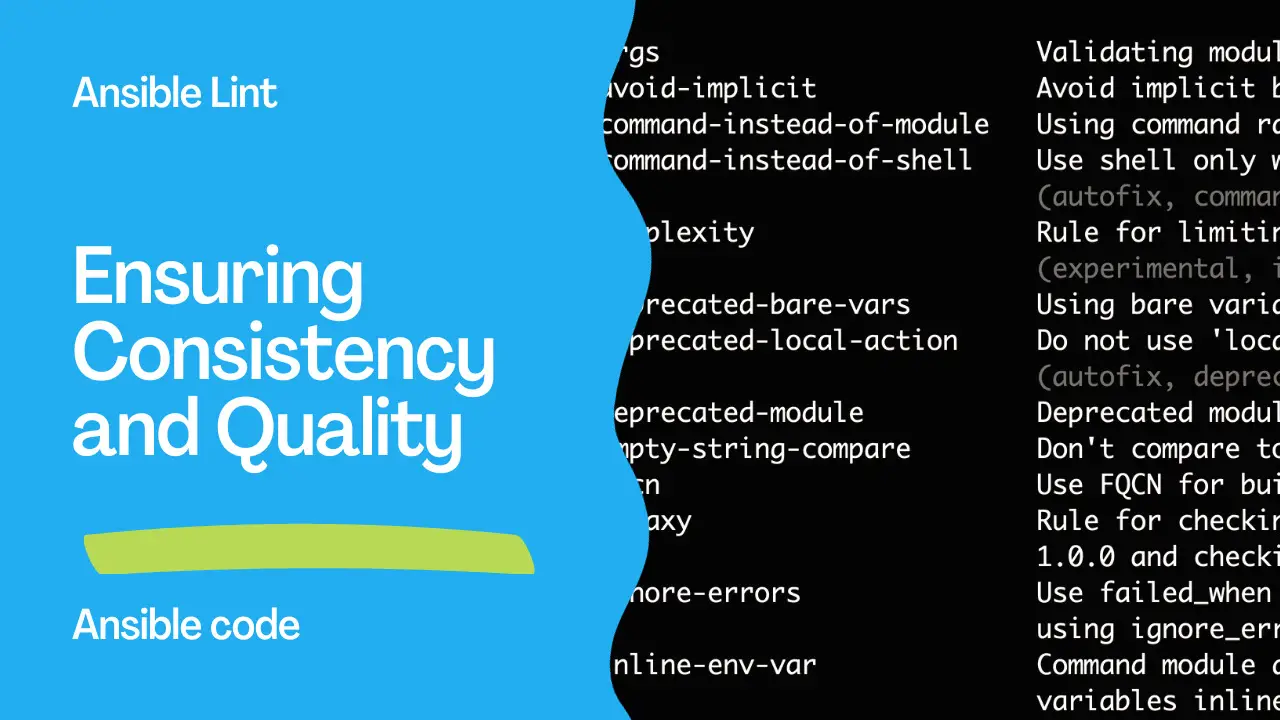Ensuring Quality with Ansible-Lint: A Guide to Best Practices
In the realm of IT automation, maintaining the quality and consistency of your Ansible playbooks and roles is crucial for effective and reliable automation. Ansible-Lint, a powerful tool for analyzing and improving Ansible code, helps achieve this by enforcing best practices and identifying potential issues. This article delves into the features, benefits, and practical applications of Ansible-Lint, providing a comprehensive guide to using it effectively.
What is Ansible-Lint?
Ansible-Lint is a command-line tool that helps identify and correct issues in Ansible playbooks, roles, and collections. It ensures that your automation code adheres to best practices and coding standards, making your automation processes more reliable and maintainable. By analyzing Ansible content for a wide range of potential issues, Ansible-Lint helps developers produce high-quality code.
Key Features and Benefits
- Improves Code Quality: Ansible-Lint checks for common issues and enforces best practices, ensuring that your playbooks and roles are written consistently and maintainably.
- Identifies Potential Issues: The tool identifies syntax errors, deprecated features, security issues, and other potential problems that might not be immediately apparent during manual reviews.
- Enhances Security: By flagging insecure practices, such as storing passwords in plain text, Ansible-Lint helps enhance the security of your automation processes.
- Facilitates Collaboration: Enforcing a standardized coding style across teams ensures that all members can understand and contribute to the automation code more effectively.
- Integration with CI/CD Pipelines: Ansible-Lint can be integrated into Continuous Integration/Continuous Deployment (CI/CD) pipelines, allowing for automated linting and ensuring code quality throughout the development lifecycle.
Installation and Setup
To begin using Ansible-Lint, you need to have Ansible installed on your system. The following steps guide you through the installation and initial setup of Ansible-Lint:
Install Ansible-Lint:
pip3 install ansible-lint ansible-lint --versionList Available Rules: Ansible-Lint comes with a comprehensive set of rules. You can list these rules using:
ansible-lint -LLint a Playbook: To lint a specific playbook, use:
ansible-lint playbook.yml
The tool will analyze the playbook and provide detailed messages indicating which rules were triggered, along with file locations and problematic lines.
Practical Applications
- Regular Code Reviews: Use Ansible-Lint during code reviews to ensure that playbooks and roles adhere to best practices and are free of common issues.
- Automated Testing: Integrate Ansible-Lint into your CI/CD pipelines to automatically check for issues whenever new code is committed, ensuring continuous code quality.
- Educational Tool: For teams new to Ansible, Ansible-Lint serves as an educational tool, guiding developers towards writing better Ansible code by enforcing best practices and providing feedback.
Best Practices for Using Ansible-Lint
- Stay Updated: Regularly update Ansible-Lint to benefit from the latest rule improvements and bug fixes.
- Integrate into CI/CD: Incorporate Ansible-Lint into your CI/CD pipelines to catch issues early in the development process.
- Use Autofix: Take advantage of autofixable rules to automatically correct issues in your playbooks.
- Check for Deprecated Features: Regularly check for deprecated features and modules in your playbooks and update them to use supported alternatives.
- Follow Naming Conventions: Adhere to role naming conventions and playbook file extensions to ensure consistency and readability.
- Prioritize Security: Pay close attention to security-related rules, such as avoiding storing passwords in plain text, to safeguard sensitive data.
Conclusion
Ansible-Lint is an invaluable tool for maintaining the quality, consistency, and security of Ansible automation code. By enforcing best practices and identifying potential issues, it helps developers produce reliable and maintainable playbooks and roles. Integrating Ansible-Lint into your development and CI/CD processes ensures that your automation efforts are efficient, secure, and compliant with industry standards.
For more detailed information on setting up and using Ansible-Lint, refer to the official documentation on GitHub.
Subscribe to the YouTube channel, Medium, and Website, X (formerly Twitter) to not miss the next episode of the Ansible Pilot.Academy
Learn the Ansible automation technology with some real-life examples in my
Udemy 300+ Lessons Video Course.

My book Ansible By Examples: 200+ Automation Examples For Linux and Windows System Administrator and DevOps

Donate
Want to keep this project going? Please donate
